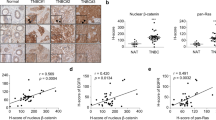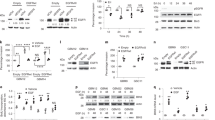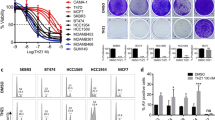Abstract
An emerging paradigm holds that loss of negative signalling to receptor tyrosine kinases (RTKs) is permissive for their oncogenic activity. Herein, we have addressed tumor suppression by RALT/MIG-6, a transcriptionally controlled feedback inhibitor of ErbB RTKs, in breast cancer cells. Knockdown of RALT expression by RNAi enhanced the EGF-dependent proliferation of normal breast epithelial cells, indicating that loss of RALT signalling in breast epithelium may represent an advantageous condition during ErbB-driven tumorigenesis. Although mutational inactivation of the RALT gene was not detected in human breast carcinomas, RALT mRNA and protein expression was strongly and selectively reduced in ERBB2-amplified breast cancer cell lines. Reconstitution of RALT expression in ERBB2-amplified SKBr-3 and BT474 cells inhibited ErbB-2-dependent mitogenic signalling and counteracted the ability of ErbB ligands to promote resistance to the ErbB-2-targeting drug Herceptin. Thus, loss of RALT expression cooperates with ERBB2 gene amplification to drive full oncogenic signalling by the ErbB-2 receptor. Moreover, loss of RALT signalling may adversely affect tumor responses to ErbB-2-targeting agents.
This is a preview of subscription content, access via your institution
Access options
Subscribe to this journal
Receive 50 print issues and online access
$259.00 per year
only $5.18 per issue
Buy this article
- Purchase on Springer Link
- Instant access to full article PDF
Prices may be subject to local taxes which are calculated during checkout







Similar content being viewed by others
References
Amatschek S, Koenig U, Auer H, Steinlein P, Pacher M, Gruenfelder A, Dekan G, Vogl S, Kubista E, Heider KH, Stratowa C, Schreiber M and Sommergruber W . (2004). Cancer Res., 64, 844–856.
Anastasi S, Fiorentino L, Fiorini M, Fraioli R, Sala G, Castellani L, Alema S, Alimandi M and Segatto O . (2003). Oncogene, 22, 4221–4234.
Bache KG, Slagsvold T and Stenmark H . (2004). EMBO J., 23, 2707–2712.
Bao J, Gur G and Yarden Y . (2003). Proc. Natl. Acad. Sci. USA, 100, 2438–2443.
Bieche I, Khodja A and Lidereau R . (1999). Genes Chromosomes. Cancer, 24, 255–263.
Brummelkamp TR, Bernards R and Agami R . (2002). Cancer Cell, 2, 243–247.
Coleman ML, Marshall CJ and Olson MF . (2004). Nat. Rev. Mol. Cell Biol., 5, 355–366.
Debnath J, Muthuswamy SK and Brugge JS . (2003). Methods, 30, 256–268.
Farabegoli F, Ceccarelli C, Santini D, Trere D, Baldini N, Taffurelli M and Derenzini M . (1996). Int. J. Cancer, 69, 381–385.
Fiorentino L, Pertica C, Fiorini M, Talora C, Crescenzi M, Castellani L, Alema S, Benedetti P and Segatto O . (2000). Mol. Cell Biol., 20, 7735–7750.
Fiorini M, Alimandi M, Fiorentino L, Sala G and Segatto O . (2001). FEBS Lett., 490, 132–141.
Fiorini M, Ballaro C, Sala G, Falcone G, Alema S and Segatto O . (2002). Oncogene, 21, 6530–6539.
Hackel PO, Gishizky M and Ullrich A . (2001). Biol. Chem., 382, 1649–1662.
Hanahan D and Weinberg RA . (2000). Cell, 100, 57–70.
Holbro T, Beerli RR, Maurer F, Koziczak M, Barbas III CF and Hynes NE . (2003). Proc. Natl. Acad. Sci. USA, 100, 8933–8938.
Kim HJ and Bar-Sagi D . (2004). Nat. Rev. Mol. Cell Biol., 5, 441–450.
Lo TL, Yusoff P, Fong CW, Guo K, McCaw BJ, Phillips WA, Yang H, Wong ES, Leong HF, Zeng Q, Putti TC and Guy GR . (2004). Cancer Res., 64, 6127–6136.
Makkinje A, Quinn DA, Chen A, Cadilla CL, Force T, Bonventre JV and Kyriakis JM . (2000). J. Biol. Chem., 275, 17838–17847.
Marmor MD and Yarden Y . (2004). Oncogene, 23, 2057–2070.
Mincione G, Bianco C, Kannan S, Colletta G, Ciardiello F, Sliwkowski M, Yarden Y, Normanno N, Pramaggiore A, Kim N and Salomon DS . (1996). J. Cell Biochem., 60, 437–446.
Moghal N and Sternberg PW . (2003). Exp. Cell Res., 284, 150–159.
Motoyama AB, Hynes NE and Lane HA . (2002). Cancer Res., 62, 3151–3158.
Murillas R, Larcher F, Conti CJ, Santos M, Ullrich A and Jorcano JL . (1995). EMBO J., 14, 5216–5223.
Nagata Y, Lan KH, Zhou X, Tan M, Esteva FJ, Sahin AA, Klos KS, Li P, Monia BP, Nguyen NT, Hortobagyi GN, Hung MC and Yu D . (2004). Cancer Cell, 6, 117–127.
Olayioye MA, Neve RM, Lane HA and Hynes NE . (2000). EMBO J., 19, 3159–3167.
Perrimon N and McMahon AP . (1999). Cell, 97, 13–16.
Peschard P and Park M . (2003). Cancer Cell, 3, 519–523.
Polo S, Pece S and Di Fiore PP . (2004). Curr. Opin. Cell Biol., 16, 156–161.
Ragnarsson G, Eiriksdottir G, Johannsdottir JT, Jonasson JG, Egilsson V and Ingvarsson S . (1999). Br. J. Cancer, 79, 1468–1474.
Saarikoski ST, Rivera SP and Hankinson O . (2002). FEBS Lett., 530, 186–190.
Siegel PM, Ryan ED, Cardiff RD and Muller WJ . (1999). EMBO J., 18, 2149–2164.
Slamon DJ, Godolphin W, Jones LA, Holt JA, Wong SG, Keith DE, Levin WJ, Stuart SG, Udove J, Ullrich A and Press MF . (1989). Science, 244, 707–712.
Suzuki H, Watkins DN, Jair KW, Schuebel KE, Markowitz SD, Dong CW, Pretlow TP, Yang B, Akiyama Y, Van Engeland M, Toyota M, Tokino T, Hinoda Y, Imai K, Herman JG and Baylin SB . (2004). Nat. Genet., 36, 417–422.
Tsukamoto K, Ito N, Yoshimoto M, Kasumi F, Akiyama F, Sakamoto G, Nakamura Y and Emi M . (1998). Cancer, 82, 317–322.
Vivanco I and Sawyers CL . (2002). Nat. Rev. Cancer, 2, 489–501.
Yarden Y and Sliwkowski MX . (2001). Nat. Rev. Mol. Cell Biol., 2, 127–137.
Acknowledgements
We thank M Fanciulli, S Giordano, N Hynes and G Piaggio for reagents, R Carsetti for cell sorting, S Alemà, D Birnbaum, PG Natali and S Soddu for discussion, R Fraioli for assistance. This work was supported by AIRC and FIRB grants to OS; G. Russo is supported by AIRC.
Author information
Authors and Affiliations
Corresponding author
Additional information
Supplementary Information accompanies the paper on Oncogene websitge (http://www.nature.com/onc)
Rights and permissions
About this article
Cite this article
Anastasi, S., Sala, G., Huiping, C. et al. Loss of RALT/MIG-6 expression in ERBB2-amplified breast carcinomas enhances ErbB-2 oncogenic potency and favors resistance to Herceptin. Oncogene 24, 4540–4548 (2005). https://doi.org/10.1038/sj.onc.1208658
Received:
Revised:
Accepted:
Published:
Issue Date:
DOI: https://doi.org/10.1038/sj.onc.1208658
Keywords
This article is cited by
-
ARG1 Is a Potential Prognostic Marker in Metastatic Endometrial Cancer
Reproductive Sciences (2024)
-
Selumetinib overcomes gefitinib primary and acquired resistance by regulating MIG6/STAT3 in NSCLC
Archives of Pharmacal Research (2023)
-
MIG-6 negatively regulates STAT3 phosphorylation in uterine epithelial cells
Oncogene (2018)
-
The novel dithiocarbamate, DpdtC suppresses HER2-overexpressed cancer cells by up-regulating NDRG1 via inactivation of HER2-ERK 1/2 signaling
Scientific Reports (2018)
-
Panobinostat Enhances Growth Suppressive Effects of Progestin on Endometrial Carcinoma by Increasing Progesterone Receptor and Mitogen-Inducible Gene-6
Hormones and Cancer (2017)



